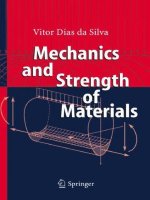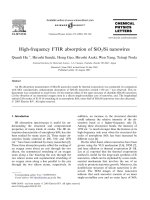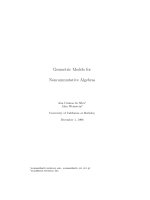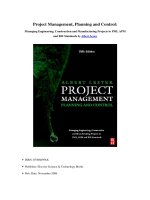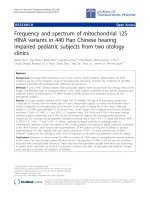da silva, e. (2001). high frequency and microwave engineering
Bạn đang xem bản rút gọn của tài liệu. Xem và tải ngay bản đầy đủ của tài liệu tại đây (14.66 MB, 440 trang )
High Frequency and Microwave Engineering
Da Silva Prelims 15:2:2001 9:33 am Page i
This book is dedicated to my wife,
Ann
for her help and encouragement in the writing of this book
Da Silva Prelims 15:2:2001 9:33 am Page ii
High Frequency and
Microwave Engineering
E. da Silva
The Open University
OXFORD AUCKLAND BOSTON JOHANNESBURG MELBOURNE NEW DELHI
Da Silva Prelims 15:2:2001 9:33 am Page iii
Butterworth–Heinemann
Linacre House, Jordan Hill, Oxford OX2 8DP
225 Wildwood Avenue, Woburn, MA 01801-2041
A division of Reed Educational and Professional Publishing Ltd
A member of the Reed Elsevier plc group
First published 2001
© E. da Silva 2001
All rights reserved. No part of this publication may be reproduced or
transmitted in any form or by any means, electronically or mechanically,
including photocopying, recording or any information storage or retrieval
system, without either prior permission in writing from the publisher or a
licence permitting restricted copying. In the United Kingdom such licences
are issued by the Copyright Licensing Agency: 90 Tottenham Court Road,
London W1P 0LP.
Whilst the advice and information in this book are believed to be true and
accurate at the date of going to press, neither the author[s] nor the publisher
can accept any legal responsibility or liability for any errors or omissions
that may be made.
British Library Cataloguing in Publication Data
A catalogue record for this book is available from the British Library
ISBN 0 7506 5646 X
Typeset in 10/12 pt Times by Cambrian Typesetters, Frimley, Surrey
Printed and bound by MPG Books Ltd, Bodmin, Cornwall
Da Silva Prelims 15:2:2001 9:33 am Page iv
Contents
Preface ix
1 BASIC FEATURES OF RADIO COMMUNICATION SYSTEMS 1
1.1 Introduction 1
1.2 Radio communication systems 2
1.3 Modulation and demodulation 3
1.4 Radio wave propagation techniques 9
1.5 Antennas and Aerials 14
1.6 Antenna arrays 23
1.7 Antenna distribution systems 25
1.8 Radio receivers 32
1.9 Radio receiver properties 33
1.10 Types of receivers 37
1.11 Summary 41
2 TRANSMISSION LINES 43
2.1 Introduction 43
2.2 Transmission line basics 45
2.3 Types of electrical transmission lines 47
2.4 Line characteristic impedances and physical parameters 50
2.5 Characteristic impedance (Z
0
) from primary electrical parameters 54
2.6 Characteristic impedance (Z
0
) by measurement 58
2.7 Typical commercial cable impedances 60
2.8 Signal propagation on transmission lines 61
2.9 Waveform distortion and frequency dispersion 63
2.10 Transmission lines of finite length 64
2.11 Reflection and transmission coefficients 64
2.12 Propagation constant (
γ
) of transmission lines 72
2.13 Transmission lines as electrical components 77
2.14 Transmission line couplers 82
2.15 Summary 98
3 SMITH CHARTS AND SCATTERING PARAMETERS 88
3.1 Introduction 88
3.2 Smith charts 89
Da Silva Prelims 15:2:2001 9:33 am Page v
3.3 The immittance Smith chart 97
3.4 Admittance manipulation on the chart 98
3.5 Smith chart theory and applications 98
3.6 Reflection coefficients and impedance networks 102
3.7 Impedance of distributed circuits 106
3.8 Impedance matching 110
3.9 Summary of Smith charts 125
3.10 Scattering parameters (s-parameters) 125
3.11 Applied examples of s-parameters in two port networks 131
3.12 Summary of scattering parameters 140
4 PUFF SOFTWARE 142
4.1 Introduction 142
4.2 CalTech’s PUFF Version 2.1 143
4.3 Installation of PUFF 143
4.4 Running PUFF 144
4.5 Examples 147
4.6 Bandpass filter 152
4.7 PUFF commands 156
4.8 Templates 157
4.9 Modification of transistor templates 163
4.10 Verification of some examples given in Chapters 2 and 3 165
4.11 Using PUFF to evaluate couplers 170
4.12 Verification of Smith chart applications 172
4.13 Verification of stub matching 176
4.14 Scattering parameters 186
4.15 Discontinuities: physical and electrical line lengths 189
4.16 Summary 192
5 AMPLIFIER BASICS 195
5.1 Introduction 195
5.2 Tuned circuits 196
5.3 Filter design 202
5.4 Butterworth filter 208
5.5 Tchebyscheff filter 224
5.6 Summary on filters 231
5.7 Impedance matching 232
5.8 Three element matching networks 252
5.9 Broadband matching networks 259
5.10 Summary of matching networks 261
6 HIGH FREQUENCY TRANSISTOR AMPLIFIERS 262
6.1 Introduction 262
6.2 Bi-polar transistors 262
6.3 Review of field effect transistors 277
6.4 A.C. equivalent circuits of transistors 291
6.5 General r.f. design considerations 304
vi Contents
Da Silva Prelims 15:2:2001 9:33 am Page vi
6.6 Transistor operating configurations 316
6.7 Summary 319
7 MICROWAVE AMPLIFIERS 320
7.1 Introduction 320
7.2 Transistors and s-parameters 321
7.3 Design of amplifiers with conjugately matched impedances 322
7.4 Design of amplifiers for a specific gain 332
7.5 Design of amplifiers for optimum noise figure 345
7.6 Design of broadband amplifiers 349
7.7 Feedback amplifiers 352
7.8 R.F. power transistors 355
7.9 Summary 35S
8 OSCILLATORS AND FREQUENCY SYNTHESISERS 357
8.1 Introduction 357
8.2 Sine wave type oscillators 358
8.3 Low frequency sine wave oscillators 361
8.4 Wien bridge oscillator 361
8.5 Phase shift oscillators 364
8.6 Radio frequency (LC) oscillators 368
8.7 Colpitts oscillator 368
8.8 Hartley oscillator 371
8.9 Clapp oscillator 372
8.10 Voltage-controlled oscillator 375
8.11 Comparison of the Hartley, Colpitts, Clapp and voltage-controlled
oscillators 376
8.12 Crystal control oscillators 376
8.13 Phase lock loops 380
8.14 Frequency synthesisers 393
8.15 Summary 399
9 FURTHER TOPICS 400
9.1 Aims 400
9.2 Signal flow graph analysis 400
9.3 Small effective microwave CAD packages 410
9.4 Summary of software 420
References 421
Index 000
Contents vii
Da Silva Prelims 15:2:2001 9:33 am Page vii
Da Silva Prelims 15:2:2001 9:33 am Page viii
Preface
This book was started while the author was Professor and Head of Department at Etisalat
College which was set up with the technical expertise of the University of Bradford,
England. It was continued when the author returned to the Open University, England.
Many thanks are due to my colleagues Dr David Crecraft and Dr Mike Meade of the Open
University, Dr L. Auchterlonie of Newcastle University and Dr N. McEwan and Dr D.
Dernikas of Bradford University. I would also like to thank my students for their many
helpful comments.
High Frequency and Microwave Engineering has been written with a view to ease of
understanding and to provide knowledge for any engineer who is interested in high
frequency and microwave engineering. The book has been set at the third level standard of
an electrical engineering degree but it is eminently suitable for self-study. The book
comprises standard text which is emphasised with over 325 illustrations. A further 120
examples are given to emphasise clarity in understanding and application of important
topics.
A software computer-aided-design package, PUFF 2.1 produced by California Institute
of Technology (CalTech) U.S.A., is supplied free with the book. PUFF can be used to
provide scaled layouts and artwork for designs. PUFF can also be used to calculate the
scattering parameters of circuits. Up to four scattering parameters can be plotted simulta-
neously and automatically on a Smith chart as well as in graphical form. In addition to the
PUFF software I have also included 42 software application examples. These examples
have been chosen to calculate and verify some of the examples given in the text, but many
are proven designs suitable for use in practical circuits. The confirmation of manual design
and CAD design is highly gratifying to the reader and it helps to promote greater confi-
dence in the use of other types of software. An article ‘Practical Circuit Design’ explain-
ing how PUFF can be used for producing layout and artwork for circuits is explained in
detail. There is also a detailed microwave amplifier design which uses PUFF to verify
circuit calculations, match line impedances, and produce the artwork for amplifier fabri-
cation. There is also a copy of CalTech’s manual on disk. This will prove useful for more
advanced work.
The book commences with an explanation of the many terms used in radio, wireless,
high frequency and microwave engineering. These are explained in Chapter 1. Chapter 2
provides a gentle introduction to the subject of transmission lines. It starts with a gradual
introduction of transmission lines by using an everyday example. Diagrams have been
Da Silva Prelims 15:2:2001 9:33 am Page ix
used to illustrate some of the characteristics of transmission lines. Mathematics has been
kept to a minimum. The chapter ends with some applications of transmission lines espe-
cially in their use as inductors, capacitors, transformers and couplers.
Chapter 3 provides an introduction to Smith charts and scattering parameters. Smith
charts are essential in understanding and reading manufacturers’ data because they also
provide a ‘picture’ of circuit behaviour. Use of the Smith chart is encouraged and many
examples are provided for the evaluation and manipulation of reflection coefficients,
impedance, admittance and matching circuits. For those who want it, Smith chart theory is
presented, but it is stressed that knowledge of the theory is not essential to its use.
The installation of PUFF software is introduced in Chapter 4. The chapter goes on to
deal with the printing and fabrication of artwork and the use and modification of templates.
Particular attention is paid to circuit configurations including couplers, transformers and
matching of circuits. Scattering parameters are re-introduced and used for solving scatter-
ing problems. Many of the examples in this chapter are used to confirm the results of the
examples given in Chapters 2 and 3.
Amplifier circuitry components are dealt with in Chapter 5. Particular attention is paid
to the design of Butterworth and Tchebyscheff filters and their uses as low pass, bandpass,
high pass and bandstop filters. Impedance matching is discussed in detail and many meth-
ods of matching are shown in examples.
Chapter 6 deals with the design of amplifiers including transistor biasing which is
vitally important for it ensures the constancy of transistor parameters with temperature.
Examples are given of amplifier circuits using unconditionally stable transistors and condi-
tionally stable amplifiers. The use of the indefinite matrix in transistor configurations is
shown by examples.
The design of microwave amplifiers is shown in Chapter 7. Design examples include
conjugately matched amplifiers, constant gain amplifiers, low noise amplifiers, broadband
amplifiers, feedback amplifiers and r.f. power amplifiers.
Oscillators and frequency synthesizers are discussed in Chapter 8. Conditions for oscil-
lation are discussed and the Barkhausen criteria for oscillation is detailed in the early part
of the chapter. Oscillator designs include the Wien bridge, phase shift, Hartley, Colpitts,
Clapp, crystal and the phase lock loop system. Frequency synthesizers are discussed with
reference to direct and indirect methods of frequency synthesis.
Chapter 9 is a discussion of topics which will prove useful in future studies. These
include signal flow diagrams and the use of software particularly the quasi-free types.
Comments are made regarding the usefulness of Hewlett Packard’s AppCAD and
Motorola’s impedance matching program, MIMP.
Finally, I wish you well in your progress towards the fascinating subject of high
frequency and microwave engineering.
Ed da Silva
x Preface
Da Silva Prelims 15:2:2001 9:33 am Page x
1
Basic features of radio
communication systems
1.1 Introduction
This chapter describes communication systems which use radio waves and signals. Radio
signals are useful for two main reasons. They provide a relatively cheap way of commu-
nicating over vast distances and they are extremely useful for mobile communications
where the use of cables is impractical.
Radio signals are generally considered to be electromagnetic signals which are broad-
cast or radiated through space. They vary in frequency from several kilohertz
1
to well over
100 GHz (10
11
Hz). They include some well known public broadcasting bands: long-wave
(155–280 kHz), medium-wave (522–1622 kHz), short-wave (3–30 MHz), very high
frequency FM band (88–108 MHz), ultra high frequency television band (470–890 MHz)
and the satellite television band (11.6 to 12.4 GHz). The frequencies
2
quoted above are
approximate figures and are only provided to give an indication of some of the frequency
bands used in Radio and TV broadcasting.
1.1.1 Aims
The aims of this chapter are to introduce you to some basic radio communications princi-
ples and methods. These include modulation (impressing signal information on to radio
carrier waves), propagation (transmission of radio carrier waves) and demodulation
(detection of radio carrier waves) to recover the original signal information.
The method we use here is to start with an overview of a communication system. The
system is then divided to show its sub-systems and the sub-systems are then expanded to
show individual circuits and items.
1.1.2 Objectives
The general objectives of this chapter are:
• to help you understand why certain methods and techniques are used for radio frequency
and high frequency communication circuits;
1
One hertz (Hz) means 1 cyclic vibration per second: 1 kHz = 1000 cyclic vibrations per second, 1 MHz =
1 000 000 cyclic vibrations per second, and 1 GHz = 1 000 000 000 cyclic vibrations per second. The word Hertz
is named after Heinrich Hertz, one of the early pioneers of physics.
2
The frequencies quoted are for Europe. Other countries do not necessarily follow the exact same frequen-
cies but they do have similar frequency bands.
Da Silva Part 1 16/2/1 11:23 am Page 1
• to appreciate the need for modulation;
• to understand the basic principles of modulation and demodulation;
• to understand the basic principles of signal propagation using antennas;
• to introduce radio receivers;
• to introduce you to the requirements of selectivity and bandwidth in radio communica-
tion circuits.
1.2 Radio communication systems
1.2.1 Stages in communication
Let’s commence with a simple communications example and analyse the important stages
necessary for communication. This is shown diagramatically in Figure 1.1. We start by
writing a letter-message, putting it in an envelope, and sending it through a post-carrier
(postal carrier system) to our destination. At the other end, our recipient receives the letter
from the post office, opens the envelope and reads our message. Why do we carry out these
actions?
We write a letter because it contains the information we want to send to our recipient.
In radio communications, we do the same thing; we use a message signal, which is an elec-
trical signal derived from analogue sound or digitally encoded sound and/or video/data
signals, as the information we want to convey. The process of putting this information into
an ‘envelope’ for transmission through the carrier is called modulation and circuits
designed for this purpose are known as modulation circuits or modulators.
We use the post office as the carrier for our letters because the post office has the abil-
ity to transmit messages over long distances. In radio communications, we use a radio
frequency carrier because a radio carrier has the ability to carry messages over long
distances. A radio frequency carrier with an enveloped message impressed on it is often
called an enveloped carrier wave or a modulated carrier wave.
When the post office delivers a letter to a destination, the envelope must be opened to
enable the message to be read. In radio communications when the enveloped carrier wave
2 Basic features of radio communication systems
Fig. 1.1 Analogy between the postal system and a radio system
Da Silva Part 1 16/2/1 11:23 am Page 2
arrives at its destination, the enveloped carrier must be ‘opened’ or demodulated to
recover the original message from the carrier. Circuits which perform this function are
known as demodulation circuits or demodulators.
The post office uses a system of postal codes and addresses to ensure that a letter is
selected and delivered to the correct address. In radio communications, selective or tuned
circuits are used to select the correct messages for a particular receiver. Amplifiers are also
used to ensure that the signals sent and received have sufficient amplitudes to operate the
message reading devices such as a loudspeaker and/or a video screen.
In addition to the main functions mentioned above, we need a post box to send our
letter. The electrical equivalent of this is the transmitting antenna. We require a letter box
at home to receive letters. The electrical equivalent of this is the receiving antenna.
1.2.2 Summary of radio communications systems
A pictorial summary of the above actions is shown in Figure 1.1. There are three main
functions in a radio communications system. These are: modulation, transmission and
demodulation. There are also supplementary functions in a radio communications
system. These include transmitting antennas,
3
receiving antennas, selective circuits,
and amplifiers. We will now describe these methods in the same order but with more
detail.
1.3 Modulation and demodulation
Before discussing modulation and demodulation, it is necessary to clarify two points: the
modulation information and the modulation method.
In the case of a letter in the postal system, we are free to write our messages (modula-
tion information) in any language, such as English, German, French, pictures, data, etc.
However, our recipient must be able to read the language we use. For example it is useless
to write our message in Japanese if our recipient can only read German. Hence the modu-
lation information system we use at the transmitter must be compatible with the demod-
ulation information system at the receiver.
Secondly, the method of putting information (modulation method) on the letter is
important. For example, we can type, use a pencil, ultra violet ink, etc. However, the reader
must be able to decipher (demodulate) the information provided. For example, if we use
ultra violet ink, the reader must also use ultra violet light to decipher (demodulate) the
message. Hence the modulation and demodulation methods must also be compatible.
In the discussions that follow we are only discussing modulation and demodulation
methods; not the modulation information. We also tend to use sinusoidal waves for our
explanation. This is because a great mathematician, Joseph Fourier,
4
has shown that peri-
odic waveforms of any shape consist of one or more d.c. levels, sine waves and cosine
waves. This is similar to the case in the English language, where we have thousands of
words but, when analysed, all come from the 26 letters of the alphabet. Hence, the sinu-
soidal wave is a useful tool for understanding modulation methods.
Modulation and demodulation 3
3
Antennas are also known as aerials.
4
Fourier analysis will be explained fully in a later section.
Da Silva Part 1 16/2/1 11:23 am Page 3
We now return to our simple radio carrier wave which is the sinusoidal wave
5
shown in
Figure 1.2.
A sinusoidal wave can be described by the expression
v
c
= V
c
cos (
ω
c
t + f
c
) (1.1)
where
v
c
= instantaneous carrier amplitude (volts)
V
c
= carrier amplitude (peak volts)
ω
c
= angular frequency in radians and
ω
c
= 2πf
c
where
f
c
= carrier frequency (hertz)
φ
c
= carrier phase delay (radians)
If you look at Figure 1.2, you can see that a sinusoidal wave on its own provides little
information other than its presence or its absence. So we must find some method of modu-
lating our information on to the radio carrier wave. We can change:
• its amplitude (V
c
) according to our information – this is called amplitude modulation
and will be described in Section 1.3.1;
• its frequency (
ω
c
) according to our information – this is called frequency modulation
and will be described in Section 1.3.2;
• its phase (
φ
c
) according to our information – this is known as phase modulation and
will be described in Section 1.3.3;
• or we can use a combination of one or more of the methods described above – this
method is favoured by digital modulation.
1.3.1 Amplitude modulation (AM)
This is the method used in medium-wave and short-wave radio broadcasting. Figure 1.3
shows what happens when we apply amplitude modulation to a sinusoidal carrier wave.
4 Basic features of radio communication systems
5
A sinusoidal wave is a generic name for a sine or cosine wave. In many cases, cosine waves are used
because of ease in mathematical manipulation.
Fig. 1.2 A sinusoidal radio carrier wave
Da Silva Part 1 16/2/1 11:23 am Page 4
Figure 1.3(a) shows the modulating wave on its own.
6
Figure 1.3(b) shows the carrier wave
on its own. Figure 1.3(c) shows the resultant wave. The resultant wave shape is due to the
fact that at times the modulating wave and the carrier wave are adding (in phase) and at
other times, the two waves are opposing each other (out of phase).
Amplitude modulation can also be easily analysed mathematically. Let the sinusoidal
modulating wave be described as
Modulation and demodulation 5
6
I have used a cosine wave here because you will see later when we use Fourier analysis that waveforms, no
matter how complicated, can be resolved into a series of d.c., sine and cosine terms and their harmonics.
Fig. 1.3 Amplitude modulation waveforms: (a) modulating wave; (b) carrier wave; (c) modulated wave
Da Silva Part 1 16/2/1 11:23 am Page 5
v
m
= V
m
cos (
ω
m
t) (1.2)
where
v
m
= instantaneous modulating amplitude (volts)
V
m
= modulating amplitude (peak volts)
ω
m
= angular frequency in radians and
ω
m
= 2πf
m
where
f
m
= modulating frequency (hertz)
When the amplitude of the carrier is made to vary about V
c
by the message signal v
m
, the
modulated signal amplitude becomes
[V
c
+ V
m
cos (
ω
m
t)] (1.3)
The resulting envelope AM signal is then described by substituting Equation 1.3 into
Equation 1.1 which yields
[V
c
+ V
m
cos (
ω
m
t)] cos (
ω
c
t +
φ
c
) (1.4)
It can be shown that when this equation is expanded, there are three frequencies, namely
(f
c
– f
m
), f
c
and (f
c
+ f
m
). Frequencies (f
c
– f
m
) and (f
c
+ f
m
) are called sideband frequen-
cies. These are shown pictorially in Figure 1.4.
The modulating information is contained in one of the sideband frequencies which must
be present to extract the original message. The bandwidth (bw) is defined as the highest
frequency minus the lowest frequency. In this case, it is (f
c
+ f
m
) – (f
c
– f
m
) = 2f
m
where
f
m
is the highest modulation frequency. Hence, a radio receiver must be able to accommo-
date the bandwidth of a signal.
7
1.3.2 Frequency modulation (FM)
Frequency modulation is the modulation method used in VHF radio broadcasting. Figure
1.5 shows what happens when we apply frequency modulation to a sinusoidal carrier wave.
Figure 1.5(a) shows the modulating wave on its own. Figure 1.5(b) shows the carrier wave
on its own. Figure 1.5(c) shows the resultant wave. The resultant wave shape is due to the
6 Basic features of radio communication systems
7
This is not unusual because speech or music also have low notes and high notes and to hear them our own
ears (receivers) must be able to accommodate their bandwidth. Older people tend to lose this bandwidth and often
are unable to hear the high notes.
Fig. 1.4 Frequency spectrum of an AM wave
Da Silva Part 1 16/2/1 11:23 am Page 6
fact that the carrier wave frequency increases when the modulating signal is positive and
decreases when the modulating signal is negative. Note that in pure FM, the amplitude of
the carrier wave is not altered.
The frequency deviation (∆f
c
) of the carrier is defined as [f
c (max)
– f
c (min)
]or
∆f
c
= f
c (max)
– f
c (min)
(1.5)
According to Carson’s rule, the frequency bandwidth required for wideband FM is approx-
imately 2 × (maximum frequency deviation + highest frequency present in the message
signal) or
bw = 2 [∆f
c
+ f
m (max)
] (1.6)
In FM radio broadcasting, the allocated channel bandwidth is about 200 kHz.
Modulation and demodulation 7
Fig. 1.5 Frequency modulation waveforms: (a) modulating wave; (b) carrier wave; (c) FM wave
Da Silva Part 1 16/2/1 11:23 am Page 7
1.3.3 Phase modulation (PM)
Phase modulation is particularly useful for digital waveforms. Figure 1.6 shows what
happens when we apply phase modulation to a sinusoidal carrier wave. Figure 1.6(a)
shows a digital modulating wave on its own. We have used a pulse waveform as opposed
to a sine wave in this instance because it demonstrates phase modulation more clearly.
Figure 1.6(b) shows the carrier wave on its own. Figure 1.6(c) shows the resultant wave.
Note particularly how the phase of the carrier waveform changes when a positive modu-
lating voltage is applied. In this particular case, we have shown you a phase change of
180°, but smaller phase changes are also possible.
Phase modulation is popularly used for digital signals. Phase modulation is synony-
mous with frequency modulation in many ways because an instantaneous change in phase
8
is also an instantaneous change in frequency and vice-versa. Hence, much of what is said
about FM also applies to PM.
8 Basic features of radio communication systems
8
Phase (
φ
) = angular velocity (
ω
) multiplied by time (t). Hence
φ
=
ω
t. Note this equation is similar to that
of distance = velocity × time. This is because
φ
= amount of angle travelled = velocity (
ω
) × time (t).
Fig. 1.6 Phase modulation waveforms: (a) modulating wave; (b) carrier wave; (c) modulated wave
Da Silva Part 1 16/2/1 11:23 am Page 8
1.3.4 Combined modulation methods
Digital signals are often modulated on to a radio carrier using both phase and amplitude
modulation. For example, an eight level coded digital signal can be modulated on to a
carrier by using distinct 90° phase changes and two amplitude levels. This is shown
diagrammatically in Figure 1.7 where eight different signals, points A to H, are encoded on
to a radio carrier. This method is also known as quadrature amplitude modulation (QAM).
1.3.5 Summary of modulation systems
In this section, we have shown you four methods by which information signals can be
modulated on to a radio carrier.
1.4 Radio wave propagation techniques
1.4.1 Properties of electromagnetic waves
In Figure 1.8 we show the case of a radio generator feeding energy into a load via a two
wire transmission line. The radio generator causes voltage and current waves to flow
towards the load. A voltage wave produces a voltage or electric field. A current wave
produces a cuurent or magnetic field. Taken together these two fields produce an electro-
magnetic field which at any instant varies in intensity along the length of the line.
The electromagnetic field pattern is, however, far from stationary. Like the voltage
on the line, it propagates from end to end with finite velocity which – for an air spaced
line – is close to the velocity of light in free space.
9
The flow of power from source to
Radio wave propagation techniques 9
9
Strictly speaking ‘free space’ is a vacuum. However, the velocity of propagation of electro-magnetic waves
in the atmosphere is practically the same as that in a vacuum and is approximately 3 × 10
8
metres per second.
Wavelength (
λ
) is defined as the ratio, velocity/frequency.
Fig. 1.7 An eight level coded signal modulated on to a radio carrier
Da Silva Part 1 16/2/1 11:23 am Page 9
load is then regarded as that of an electromagnetic wave propagating between the
conductors.
The equivalence between the circuit and field descriptions of waves on transmission
lines is demonstrated by the fact that at any point in the electromagnetic field the instan-
taneous values of the electric field (E) (volts/metre) and the magnetic field (H)
(amperes/metre) are related by
E(V/m)
———— = Z
0
(ohms) (1.7)
H(A/m)
where Z
0
is the characteristic impedance of the transmission line.
10
It can also be
shown that both approaches give identical results for the power flow along a matched
line.
In the two wire transmission line shown in Figure 1.8, the parallel conductors produce
electromagnetic fields which overlap and cancel in the space beyond the conductors. The
radio frequency energy is thus confined and guided by the conductors from the source to
its destination. If, however, the conductor spacing is increased so that it becomes com-
parable with the wavelength of operation the line will begin to radiate r.f. energy to its
surroundings. The energy is lost in the form of free-space electromagnetic waves which
radiate away from the line with the velocity of light.
The 19th century mathematician James Clerk Maxwell was the first to recognise that
electromagnetic waves can exist and transport energy quite independently of any system
of conductors. We know now that radio waves, heat waves, visible light, X-rays are all
electromagnetic waves differing only in frequency. Figure 1.9 shows the range of frequen-
cies and the regions occupied by the different types of radiation. This is known as the elec-
tromagnetic spectrum.
10 Basic features of radio communication systems
10
Transmission lines have impedances because they are constructed from physical components which have
resistance, self inductance, conductance and capacitance.
Fig. 1.8 Energy propagation in a transmission line
Fig. 1.9 The electromagnetic frequency spectrum
Da Silva Part 1 16/2/1 11:23 am Page 10
1.4.2 Free-space radiation
Introduction
At operational frequencies, where the operational wavelengths are comparable in size to
circuit components,
11
any circuit consisting of components connected by conductors will
tend to act as an imperfect transmission line. As a result, there will always be some loss of
r.f. energy by way of radiation. In other words, the circuit will tend to behave like a crude
radio transmitter antenna.
It follows that for minimal radiation, components should be small with respect to their
operational wavelengths. Conversely, if radiation is desired, then the physical components
should be large, approximately 1/4 wavelength for optimum radiation. This is why anten-
nas are physically large in comparison with their operational wavelength.
Energy radiates from an r.f. source or transmitter in all directions. If you imagine a
spherical surface surrounding the transmitter, then the interior of the surface would be
‘illuminated’ with radiated energy, just like the inside of a globular lamp-shade. The illu-
mination is not necessarily uniform, however, since all transmitters are, to some extent,
directional.
If the r.f. source is sinusoidal, then the electric and magnetic fields will also be varying
sinusoidally at any point in the radiation field. Now it is difficult to depict a propagating elec-
tromagnetic field but some of its important properties can be identified. To do this we
consider propagation in a particular direction on a straight line connecting a transmitter to a
distant receiver as shown in Figure 1.10. You will see that this line coincides with the z-direc-
tion in Figure 1.10. Measurements at the radio receiver would then indicate that the oscillat-
ing electric field is acting all in one direction, the x-direction in Figure 1.10. The magnetic
field is in-phase with the electric field but acts at right-angles to the electric field, in the y-
direction. The two fields are thus at right-angles to each other and to the direction of propa-
gation. An electromagnetic wave with these characteristics is known as a plane wave.
Radio wave propagation techniques 11
11
Generally taken to be the case when the operational wavelength is about 1/20 of the physical size of compo-
nents.
Fig. 1.10 Electric and magnetic field directions for an electromagnetic wave propagating in the z-direction
Da Silva Part 1 16/2/1 11:23 am Page 11
Polarisation
Provided there is no disturbance in the propagation path, the electric and magnetic field
orientations with respect to the earth’s surface will remain unchanged. By convention, the
orientation of the electric field with respect to the earth’s surface is called the polarisation
of the electromagnetic wave. If the electric field is vertical, the wave is said to be verti-
cally polarised; if horizontal, the wave is horizontally polarised. A wave is circularly
polarised if its electric field rotates as the wave travels. Circular polarisation can be either
clockwise or anti-clockwise.
Polarisation is important because antennas must be mounted in the correct plane for
optimum signal reception.
12
Terrestrial broadcasting stations tend to use either vertical or
horizontal polarisation. Satellite broadcasting stations use circular polarisation. The polar-
isation of a wave is sometimes ‘twisted’ as it propagates through space. This twisting is
caused by interfering electric or magnetic fields. It is particularly noticeable near steel-
structured buildings where aerials are mounted at odd angles to the vertical and horizontal
planes to compensate for these effects.
Field strength
The strength of a radio wave can be expressed in terms of the strength of its electric
field or by the strength of its magnetic field. You should recall that these are measured
in units of volts per metre and amperes per metre respectively. For a sinusoidally vary-
ing field it is customary to quote r.m.s. values E
rms
and H
rms
. What is the physical
significance of E
rms
? This is numerically equal to the r.m.s. voltage induced in a
conductor of length 1 m when a perpendicular electromagnetic wave sweeps over the
conductor with the velocity of light.
As stated earlier, the electric and magnetic fields in a plane wave are everywhere in
phase. The ratio of the field strengths is always the same and is given by
This ratio is called the free-space wave impedance. It is analogous to the characteristic
impedance of a transmission line.
Example 1.1
The electric field strength at a receiving station is measured and found to have an r.m.s
value of 10 microvolts/m. Calculate (a) the magnetic field strength; (b) the amount of
power incident on a receiving aerial with an effective area of 5 m
2
.
Given: Electric field strength = 10 microvolts/m.
Required: (a) Magnetic field strength, (b) incident power on a receiving aerial with effec-
tive area of 5 m
2
.
12 Basic features of radio communication systems
12
You can see this effect by looking at TV aerials mounted on houses. In some districts, you will see aerials
mounted horizontally whilst in other areas you will find aerials mounted vertically. As a general rule, TV broad-
casting authorities favour horizontal polarisation for main stations and vertical polarisation for sub or relay
stations.
electric field strength V m
magnetic field strength A m
rms
rms
E
H
()
()
= 377Ω
(1.8)
Da Silva Part 1 16/2/1 11:24 am Page 12
Solution. Using equation 1.8
(a) H
rms
= 10 µV/m/377 Ω = 2.65 × 10
–8
A/m
(b) Power density is given by
E
rms
× H
rms
= 10 × 10
–6
× 2.65 × 10
–8
W/m
2
= 2.65 × 10
–13
W/m
2
This is the amount of power incident on a surface of area 1 m
2
. For an aerial with area
5m
2
, the total incident power will be
P = 2.65 × 10
–13
W/m
2
× 5 m
2
= 1.33 pW
Power density
The product E
rms
× H
rms
has the dimensions of ‘volts per metre’ times ‘amps per metre’,
giving watts per square metre. This is equivalent to the amount of r.f. power flowing
through one square metre of area perpendicular to the direction of propagation and is
known as the power density of the wave. The power density measures the intensity of the
‘illumination’ falling on a receiving aerial.
A plane wave expands outwards as it travels through space from a point source. As a
result, the power density falls off with increasing distance from the source. If you have
studied any optics then you will be familiar with the idea that the power density falls off
as the square of the distance from the source, i.e.
where P
D1
, P
D2
= power densities at distances D
1
and D
2
respectively.
Example 1.2
If the data in Example 1.1 applies to a receiver located 10 km from the transmitter, what
will be the values of E
rms
and H
rms
at a distance of 100 km?
Given: Data of Example 1.1 applied to a receiver at 10 km from transmitter.
Required: (a) E
rms
at 100 km, (b) H
rms
at 100 km.
Solution. Using Equation 1.9 at a distance of 100 km, the power density will be reduced
by a factor (10/100)
2
= 0.01, so power density = 2.65 × 10
–15
W/m
2
. Now, power density
= E
rms
× H
rms
and since H
rms
= E
rms
/377 (Equation 1.7)
Hence
and
H
rms
= 1 µV/m/377 Ω = 2.65 × 10
–9
A/m
Radio wave propagation techniques 13
P
P
D
D
D2
D1
=
⎡
⎣
⎢
⎤
⎦
⎥
1
2
2
E
rms
2
Wm
377
265 10
15
2
=×
−
.
Em
rms
V=××=
−
2 65 10 377 1
15
. µ
(1.9)
Da Silva Part 1 16/2/1 11:24 am Page 13
Summary of propagation principles
Several important points have been established in Section 1.4.
• R.F. energy is radiated by way of travelling electric and magnetic fields which together
constitute an electromagnetic wave propagating in free space with the velocity of light.
• In a plane wave, the electric and magnetic fields vary in phase and act at right-angles to
each other. Both fields are at right-angles to the direction of propagation.
• The direction of the electric field determines the polarisation of a plane wave.
• At any point, the ratio of the electric and magnetic fields is the same and equal to the
wave impedance. This impedance is 377 W approximately.
• The product E
rms
× H
rms
gives the power density of the wave.
• The power density falls off as the square of the distance from the r.f. source.
• To obtain optimum signal reception from free space a receiving aerial should be set for
the correct polarisation and be suitably located with regard to height and direction.
1.5 Antennas and aerials
1.5.1 Introduction
An antenna or aerial is a structure, usually made from good conducting material, that has
been designed to have a shape and size so that it will provide an efficient means of trans-
mitting or receiving electromagnetic signals through free space. Many of the principles
used in the construction of antennas can be easily understood by analogy to the headlamp
of your car (see Figure 1.11).
An isotropic light source is a light source which radiates light equally in all directions.
The radiation pattern from an isotropic light source can be altered by placing a reflecting
mirror on one side of the light source. This is carried out in car headlamps where a quasi-
parabolic reflecting mirror (reflector) is placed behind a bulb to increase the light intensity
of the lamp in the forward direction. The reflector has therefore produced a change in the
directivity of the light source. The increase or ‘gain’ of light intensity in the forward direc-
tion has been gained at the expense of losing light at the back of the lamp. This gain is not
a ‘true gain’ because total light energy from the lamp has not been increased; light energy
has only been re-directed to produce an intensity gain in the forward direction.
14 Basic features of radio communication systems
Fig. 1.11 Radiation patterns from a car headlamp: (a) top view; (b) side view
Da Silva Part 1 16/2/1 11:24 am Page 14
The forward light intensity of a car lamp can be further improved by using one or more
lenses to concentrate its forward light into a main beam or main lobe. Again, this ‘gain’
in light intensity has been achieved by confining the available light into a narrower beam
of illumination; there has been no overall gain in light output from the bulb.
There are also optimum sizes and distances for the placement of reflectors and lenses.
These are dictated by the physical size of the bulb, the desired gain intensity of the main
beam or main lobe, the required width of the main beam and the requirement to suppress
minor or spurious light lobes which consume energy and cause unnecessary glare to on-
coming motorists.
A car headlamp (Figure 1.11) has two main light-emitting patterns; a horizontal pattern
and a vertical pattern. The horizontal pattern (Figure 1.11(a)) is a bird’s eye view of the
illumination pattern. A plot of the horizontal pattern is called a polar diagram. The verti-
cal or azimuth pattern (Figure 1.11(b)) is the pattern seen by an observer standing to one
side of the lamp. The vertical pattern is sometimes called the end-fire pattern. Both light
patterns must be considered because modern headlamp reflectors tend to be elliptical and
affect emitted light in the horizontal and vertical planes differently.
In the above description, light has been assumed to travel from bulb to free space but
the effect is equally true for light travelling in the opposite direction, i.e. the system is bi-
directional. It can be used either for transmitting light from the bulb or for receiving exter-
nal light at the point source usually occupied by the bulb filament. This can be easily
verified by shining an external light source through the lens and the reflector in the oppo-
site direction from which light had emerged, and seeing it converge on the bulb source.
13
Many of the principles introduced above apply to antennas as well. Because of its bi-
directional properties, a radio antenna can be used for transmitting or receiving signals.
1.5.2 Radiating resistance
The relationship, power (watts) = (volts
2
/ohms), is used for calculating power loss in a circuit.
It is not always possible to apply this law directly to a radiating circuit because a physical
resistor does not always exist. Yet we cannot deny that there is a radiated power loss when a
voltage is applied across a radiating circuit. To overcome this problem, engineers postulate an
‘equivalent’ resistor to represent a physical resistor which would absorb the same radiated
power loss. This equivalent resistor is called the radiating resistance of the circuit.
The radiating resistance of an antenna should not be confused with its input impedance.
The input impedance is the value used when considering the connection of an antenna to
a transmission line with a specified characteristic impedance. Antennas are bi-directional
and it is not uncommon to use the same antenna for transmitting and receiving signals.
Example 1.3
A transmitter with an output resistance of 72 W and an r.m.s. output of 100 V is connected
via a matched line to an antenna whose input resistance is 72 W. Its radiation resistance is
also 72 W. Assuming that the antenna is 100% efficient at the operating frequency, how
much power will be transmitted into free space?
Antennas and aerials 15
13
If you have any doubts about the system being bi-directional, you should visit a lighthouse which uses a
similar reflector and lens system. Curtains must be drawn around the system during daylight hours because
sunlight acting on the system has been known to produce such high light and heat intensities that insulation melt-
down and fires have been caused.
Da Silva Part 1 16/2/1 11:24 am Page 15
